Carl Zeiss 10x26 WinkelfernrohrDas 10x26 Winkelfernrohr (oder Grabenperiskop) von Zeiss wurde in seiner monokularen Ausführung nur in kleiner Serie (ca. 100 St.) in 1915 hergestellt. Mir sind bislang 6 Exemplare bekannt: #591733, #591827, #591867, #591878 und je ein Exemplar im Opt. Museum in Jena und einer privaten Sammlung.Das Modell ist feldgrau lackiert. Es hat ein halbrundes Prismengehäuse mit 3 Teilprismen des Porro-2-Prismensystems, einen konischen Tubus, einen Objektivkopf mit drehbarem Verschlussdeckel und eine schwarz lackierte Okular mit umlaufender Dioptrienskala (markiert bei 5) und Bakelit-Augenmuschel. Am Prismengehäuse ist eine Achse für den ausklappbaren Hartholz-Handgriff eingegossen. Mit diesem Griff lässt sich das Winkelfernrohr senkrecht vor dem Auge halten. Dabei rastet mittels einer Druckfeder der Griff in Halteposition ein. Der Holzgriff hat auch eine Anknöpflasche bzw. -öffnung. Die Beschriftung des Gehäuses auf der Okularseite ist das Zeiss-Linsenlogo und die Seriennummer. Auf der gegenüberliegenden Seite (Griffseite) befindet sich ein zweifach verschraubter runder Deckel. |
Carl Zeiss 10x26 PeriscopeThe 10x26 (trench) periscope by Zeiss was made as a monocular version only in a small number (c. 100 pcs.) in 1915. I know only six pieces: #591733, #591827, #591867, #591878 and one model each in the Opt. Museum in Jena and in a private collection.The model is painted field-grey. It has a semi-circular prism housing with 3 prism parts of the Porro 2 system, a conical tube, an objective head with a rotatable sleeve, and a black painted eyepiece with a full dioptre scale being marked at 5 and having a Bakelite eyecup. There is a cast-in axis for the foldable wooden handle. The handle allows positioning the periscope vertical in front of the eye. The handle snaps into position by means of a spring. The wooden handle also comes with a button hole. The markings on the housing on the eyepiece side are the lens logo and the serial number. On the opposite handle side is a cover plate with two screws. |


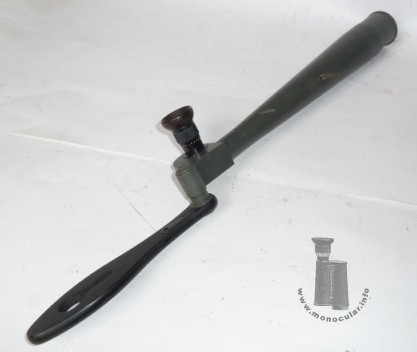
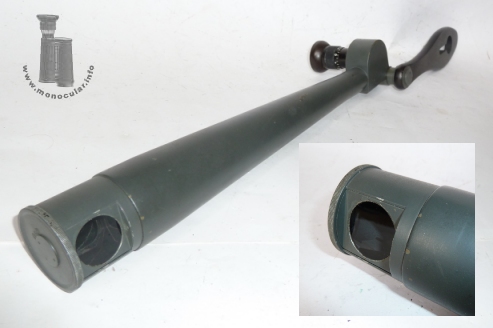
| Das Winkelfernrohr wiegt 715g. Es ist 385mm lang und mit ausgeklapptem Handgriff 17cm länger. Der Griff selbst ist 195mm lang, 47mm an der breitesten Stelle und ca. 10mm dick. Das Prismengehäuse ist 45x45mm (bzw. 45mm im Durchmesser) und 25mm dick. Der Tubus verbreitert sich von 24 auf 47mm. Bis zum Objektivteil ist er 28,2cm lang. Der Objektivkopf ist 41mm lang. Das Objektivfenster in der drehbaren Schutzhülse ist 31x31mm. Das Okularstück ist 20mm, der Fokussierungsring 23mm und die Augenmuschel 33mm im Durchmesser. | The periscope weighs 715g. It is 385mm long and when the handle is folded out this adds 17cm. The handle itself is 195mm long, 47mm wide at its widest part, and about 10mm thick. The prism housing is 45x45mm (or 45mm in diameter) and 25mm thick. The tube increases from 24mm to 47mm. It is 28.2cm long from the start to the objective head. The latter is 41mm long. The objective window in the rotatable protection tube is 31x31mm. The eyepiece measures 20mm, the focusing ring 23mm, and the eyecup 33mm in diameter. |
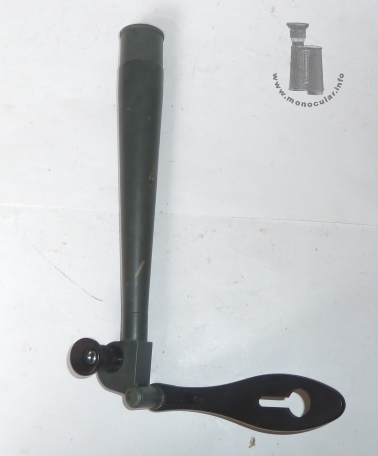
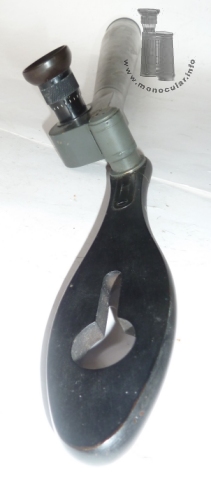
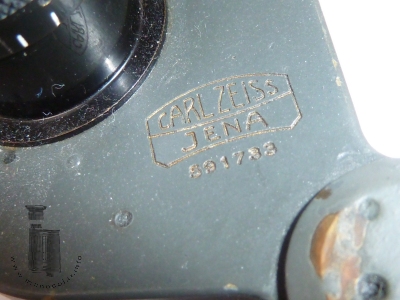
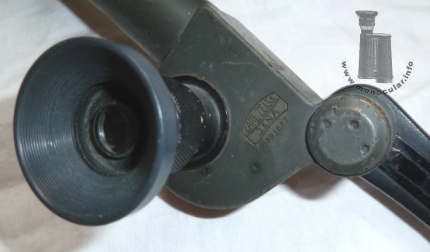
| Das Exemplar mit Nr. 591878 scheint ein schwrz überlackiertes Modell zu sein - feldgraue Lackierung ist an Stellen mit fehlenden schwarzem Lack teilweise erkennbar. Der Handgriff ist kürzer, aber entspricht im Grunde dem Holzteil bis zur Anknöpföffnung im Griff, so dass sich vermuten lässt, dass der Holzgriff an der Stelle gebrochen war und danach dort neu geschliffen und lackiert wurde. | The specimen with No. 591878 seems to be a model re-painted in black - some field-grey painz is visisble in those spots where the black lacquer wore off. The handle is shorter, but is basically the same wooden part reaching to the button-hole in the original grip so that one can assume that the wooden handle was broken at this spot, and then was filed and painted anew in that place. |

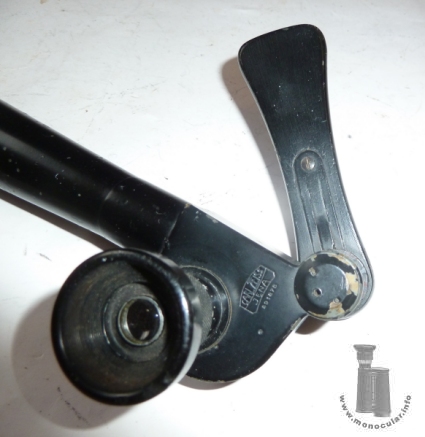
| Vgl. a. das Carl Zeiss Wien 6x26 Winkelfernrohr. | Also cf. the Carl Zeiss Wien 6x26 periscope. |
Fotos: Zeun

